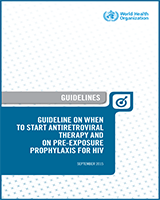Overview
This early-release guideline makes available two key recommendations that were developed during the revision process in 2015. First, antiretroviral therapy (ART) should be initiated in everyone living with HIV at any CD4 cell count. Second, the use of daily oral pre-exposure prophylaxis (PrEP) is recommended as a prevention choice for people at substantial risk of HIV infection as part of combination prevention approaches. The first of these recommendations is based on evidence from clinical trials and observational studies released since 2013 showing that earlier use of ART results in better clinical outcomes for people living with HIV compared with delayed treatment. The second recommendation is based on clinical trial results confirming the efficacy of the ARV drug tenofovir for use as PrEP to prevent people from acquiring HIV in a wide variety of settings and populations.
The recommendations in this guideline will form part of the revised consolidated guidelines on the use of ARV drugs for treating and preventing HIV infection to be published by WHO in 2016. The full update of the guidelines will consist of comprehensive clinical recommendations together with revised operational and service delivery guidance to support implementation.
This early-release guideline will form part of the revised updated WHO consolidated guidelines on the use of antiretroviral drugs for treating and preventing HIV infection due to be published in 2016.
The designations employed and the presentation of the material in this publication do not imply the expression of any opinion whatsoever on the part of the World Health Organization concerning the legal status of any country, territory, city or area or of its authorities, or concerning the delimitation of its frontiers or boundaries. Dotted and dashed lines on maps represent approximate border lines for which there may not yet be full agreement.
The mention of specific companies or of certain manufacturers' products does not imply that they are endorsed or recommended by the World Health Organization in preference to others of a similar nature that are not mentioned. Errors and omissions excepted, the names of proprietary products are distinguished by initial capital letters.
All reasonable precautions have been taken by the World Health Organization to verify the information contained in this publication. However, the published material is being distributed without warranty of any kind, either expressed or implied. The responsibility for the interpretation and use of the material lies with the reader. In no event shall the World Health Organization be liable for damages arising from its use.

